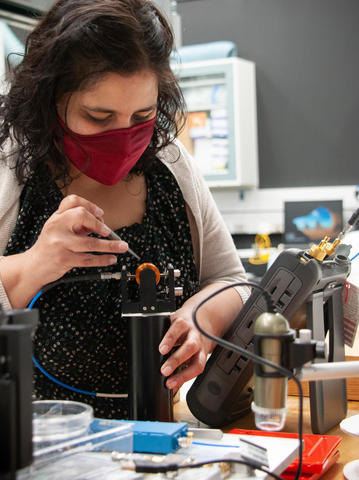
A passion undeterred — guest researcher (and former postdoc) Nandita Abhyankar took a detour between her graduate studies and current scientific endeavors, but inspiration from a Nobel Prize laureate put her back on a path toward research and eventually to NIST.
Nandita knew she wanted to be a scientist at an early age, so she pursued higher education and earned a master’s degree in chemistry at Pune University in India. However, like so many others navigating post-college life, she meandered down a different path for a while. Instead of continuing her original quest of being a scientist, Nandita worked for several years as an instructional designer, exploring learning and the teaching of children and adults.
Then, a chance conversation with a friend led Nandita to lectures by chemist Harold Kroto. He spoke of fullerenes — a new form of carbon, for which he, Robert Curl and Richard Smalley together won the Nobel Prize in 1996.
Inspired by his humility and approachability, Nandita contacted the Nobel laureate to ask about opportunities to work as a graduate student in his lab. He didn’t have any, but he directed her to one of his collaborators at Florida State University (FSU).
So, Nandita rejoined the research community. At FSU, she studied the way hybrid crystalline materials — made of metallic ions linked together by organic molecules — transitioned from one form of magnetic/electric material to another.
When she obtained her Ph.D., Nandita contacted NIST researcher Veronika Szalai about an opening in her lab. One year later, she made it onto Veronika’s team for a postdoctoral associateship. Now, Nandita continues her journey with us as a guest researcher based at the University of Maryland’s Institute for Research in Electronics and Applied Physics.
Here at NIST, Nandita approaches research from a different perspective that requires a whole new set of skills compared with the ones she learned in her doctoral training. Previously, she focused on studying materials with a technique called electron paramagnetic resonance (EPR) spectroscopy. Now, she’s designing tiny devices called microresonators to enhance the technique itself.
The devices act as lenses, squeezing the magnetic field from microwaves down to a tiny volume and enabling EPR studies of samples smaller than a nanoliter. In the near future, they may help generate measurements of precious protein samples and materials that are used in sensors, capacitors, photovoltaic systems and quantum technologies.
Nandita’s pivot back into science started with a lecture that inspired her.
What will inspire you?
Follow us on social media for more like this from all across NIST!

